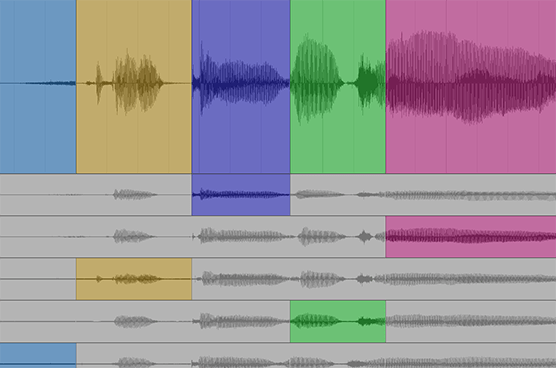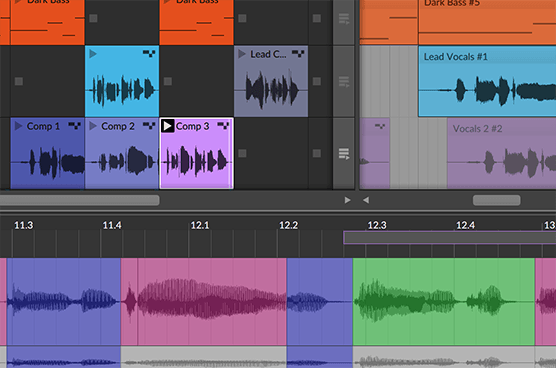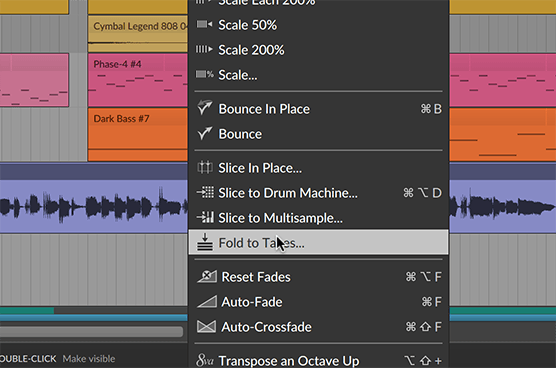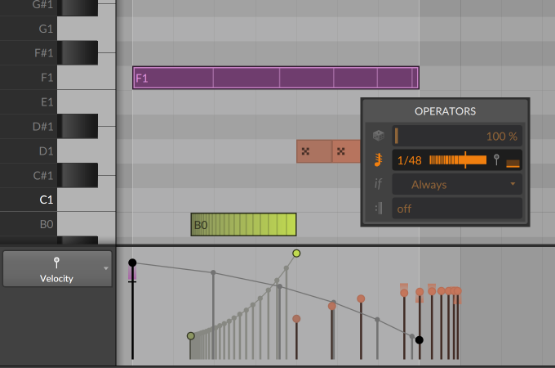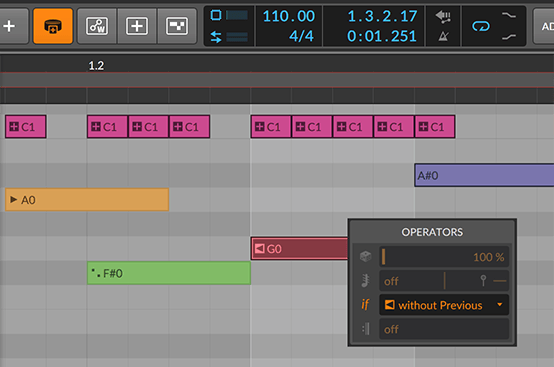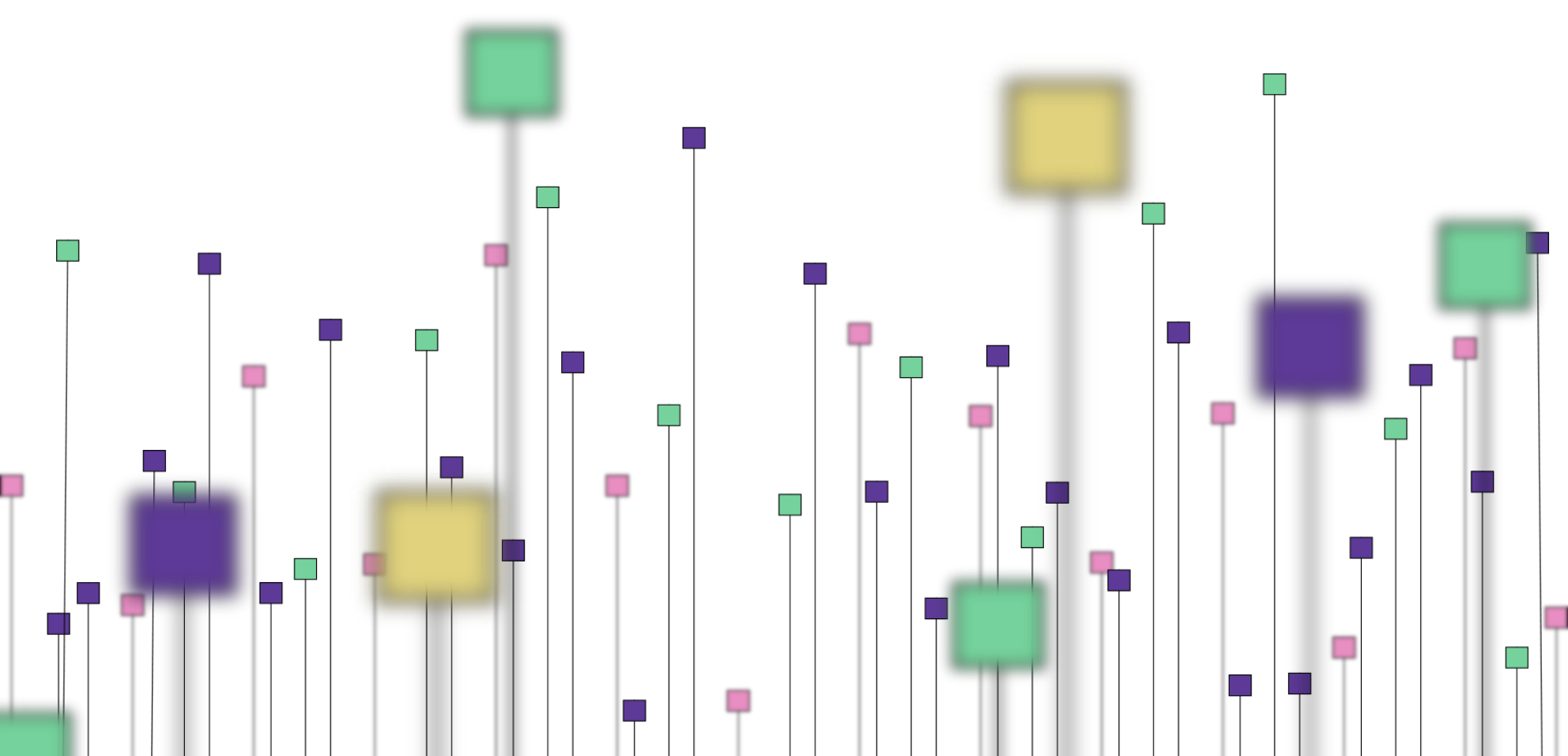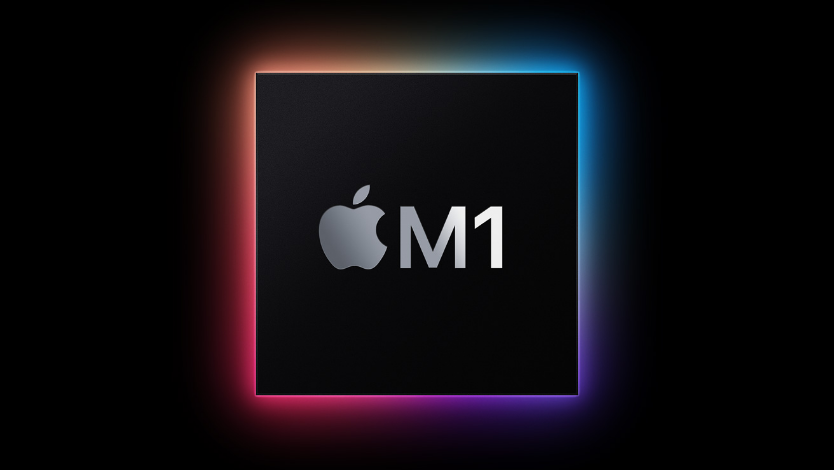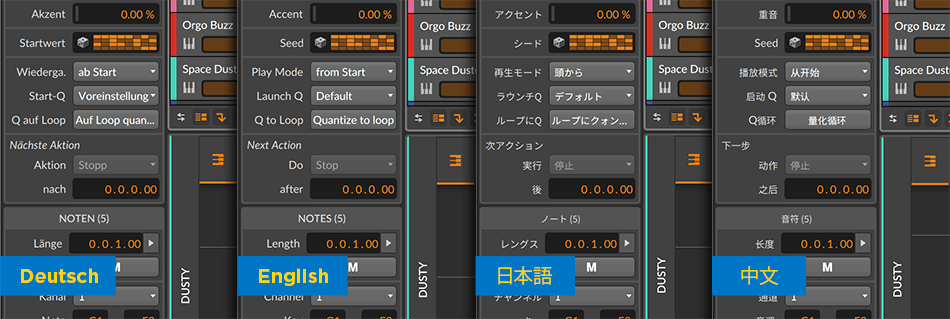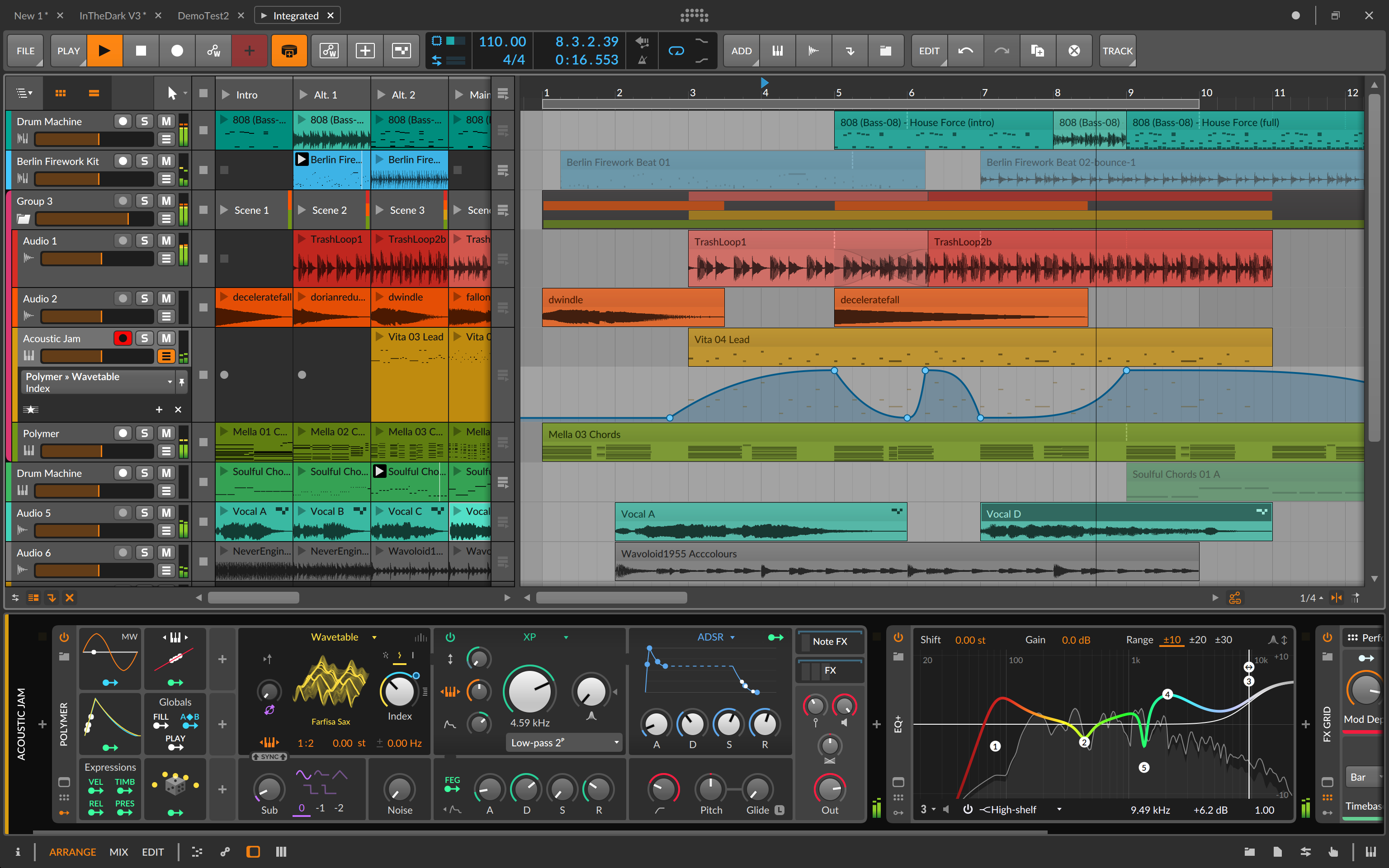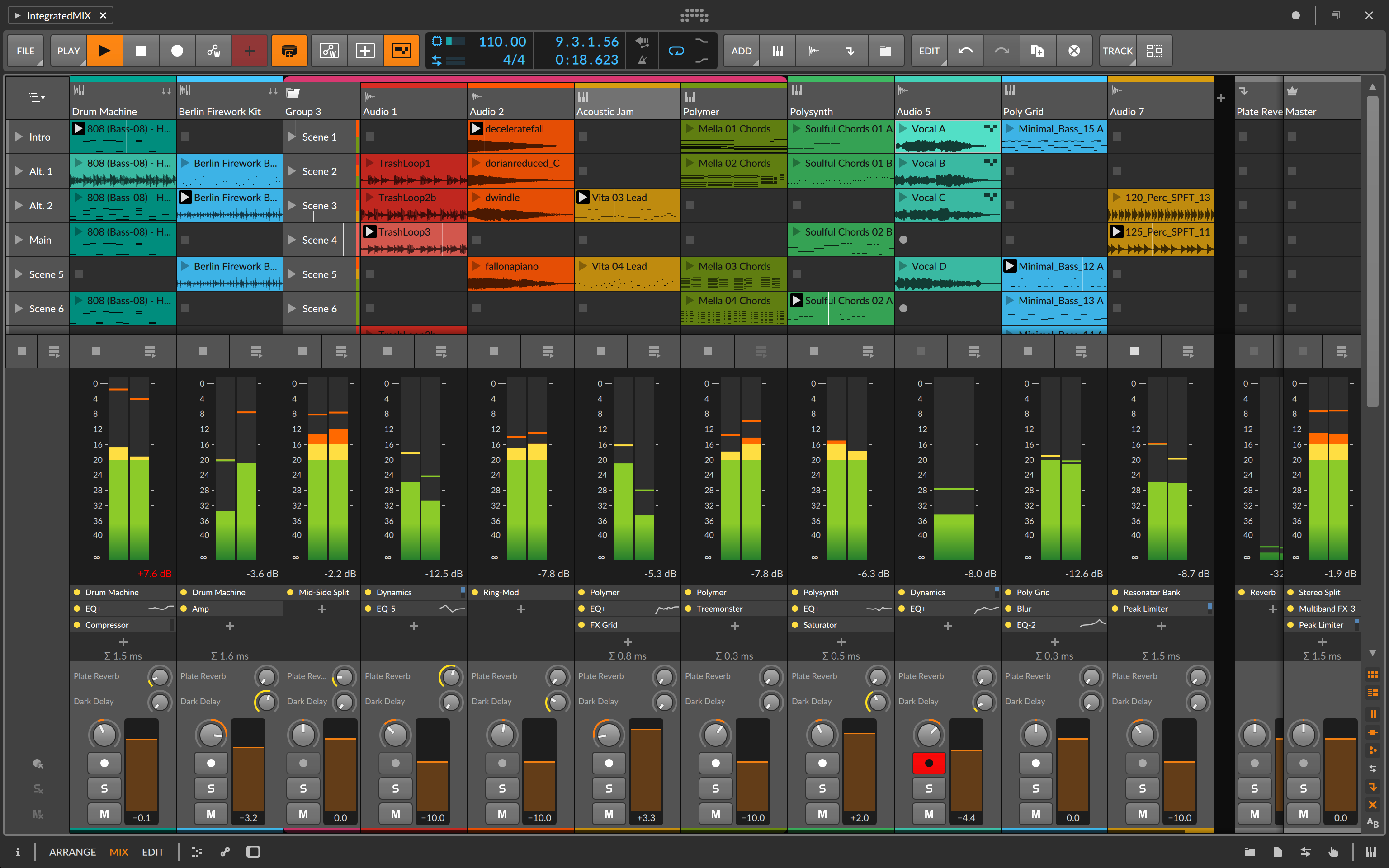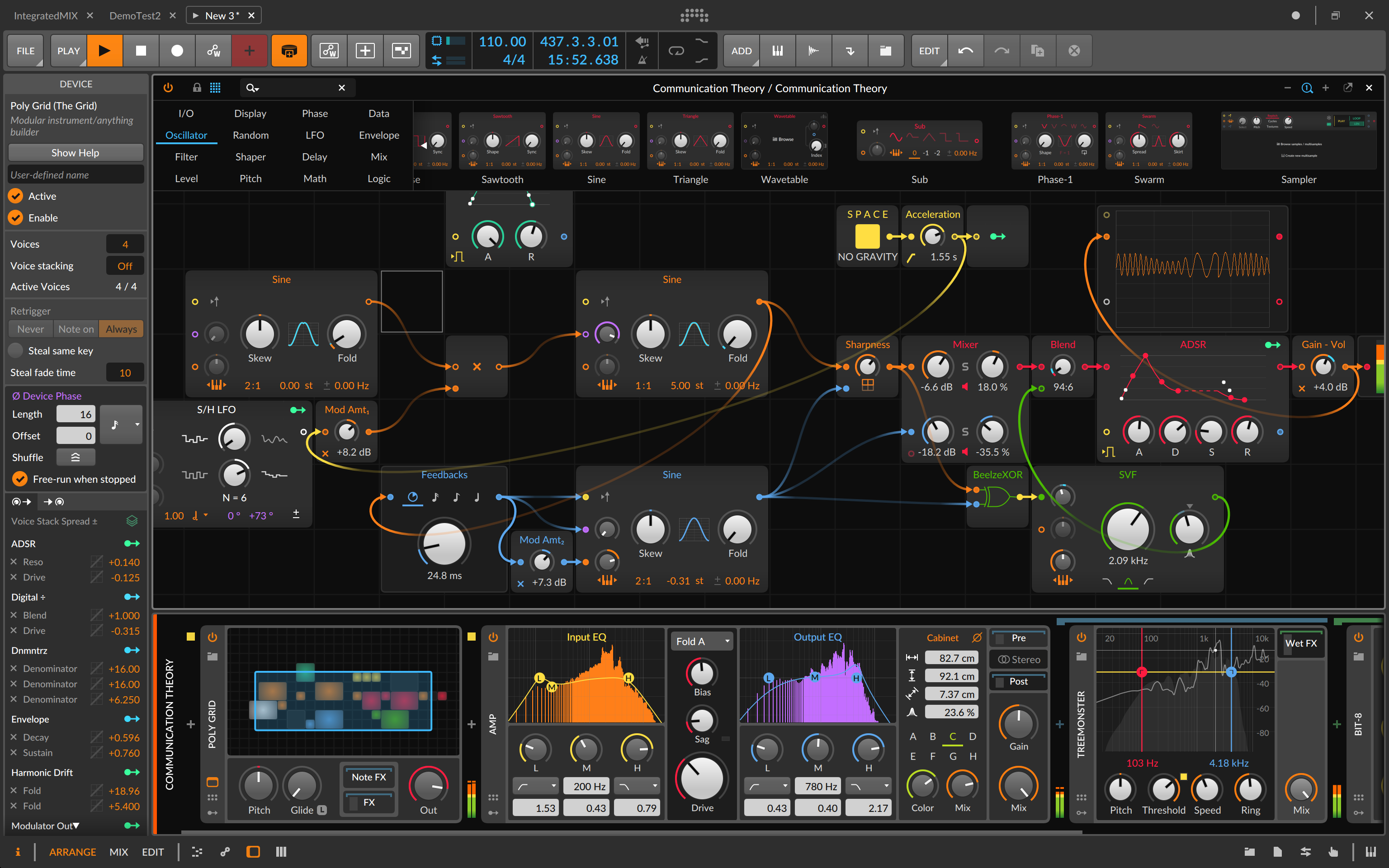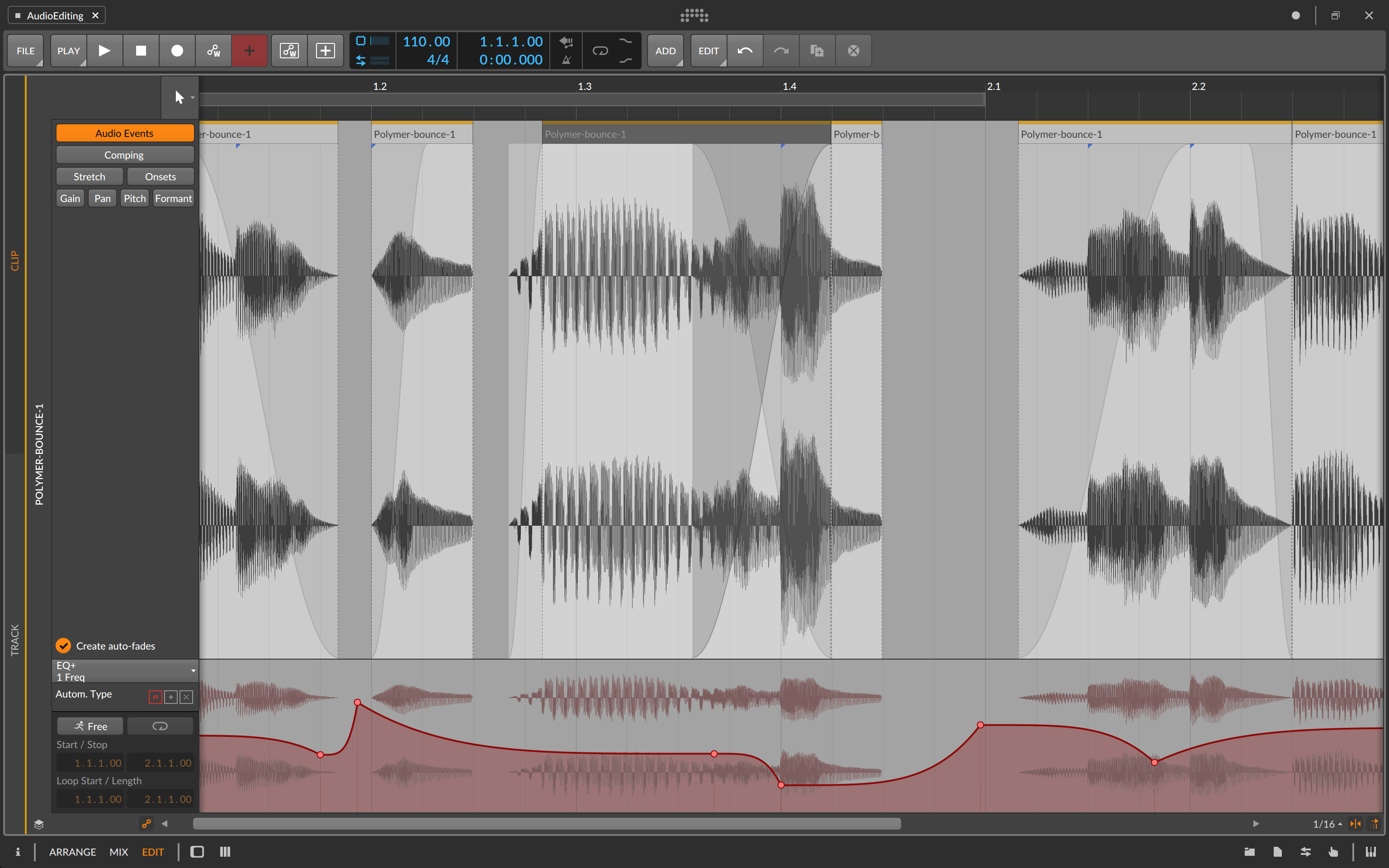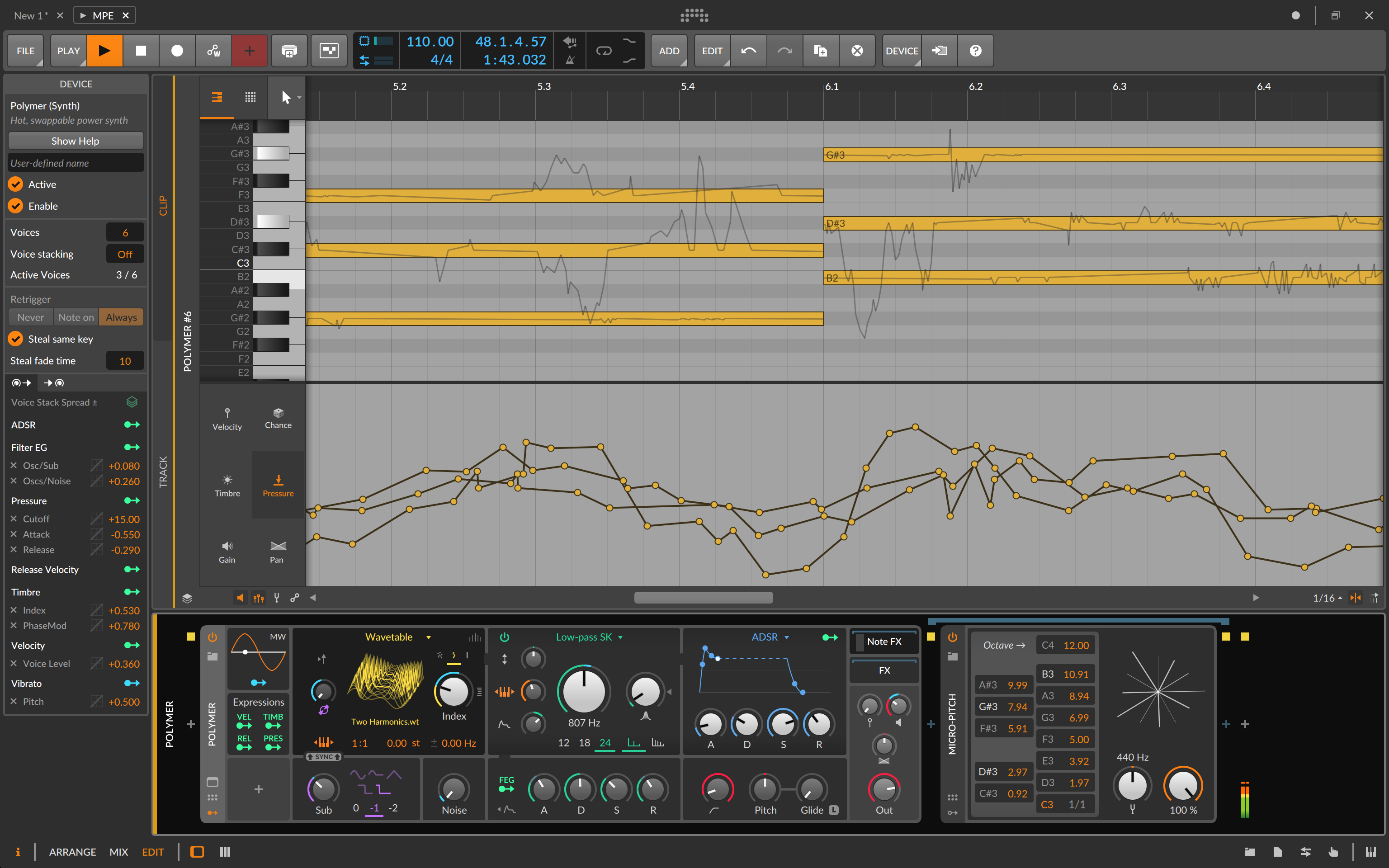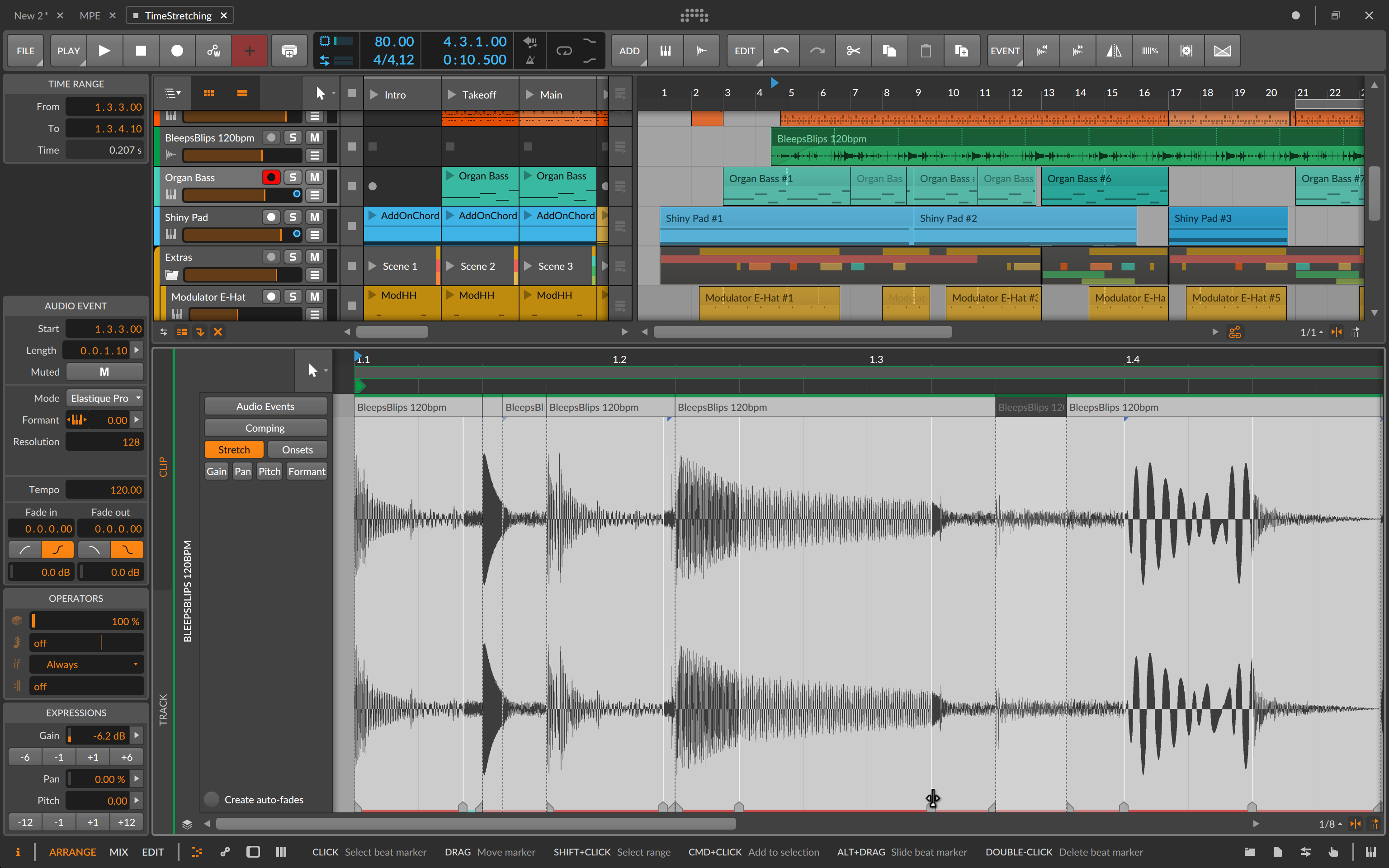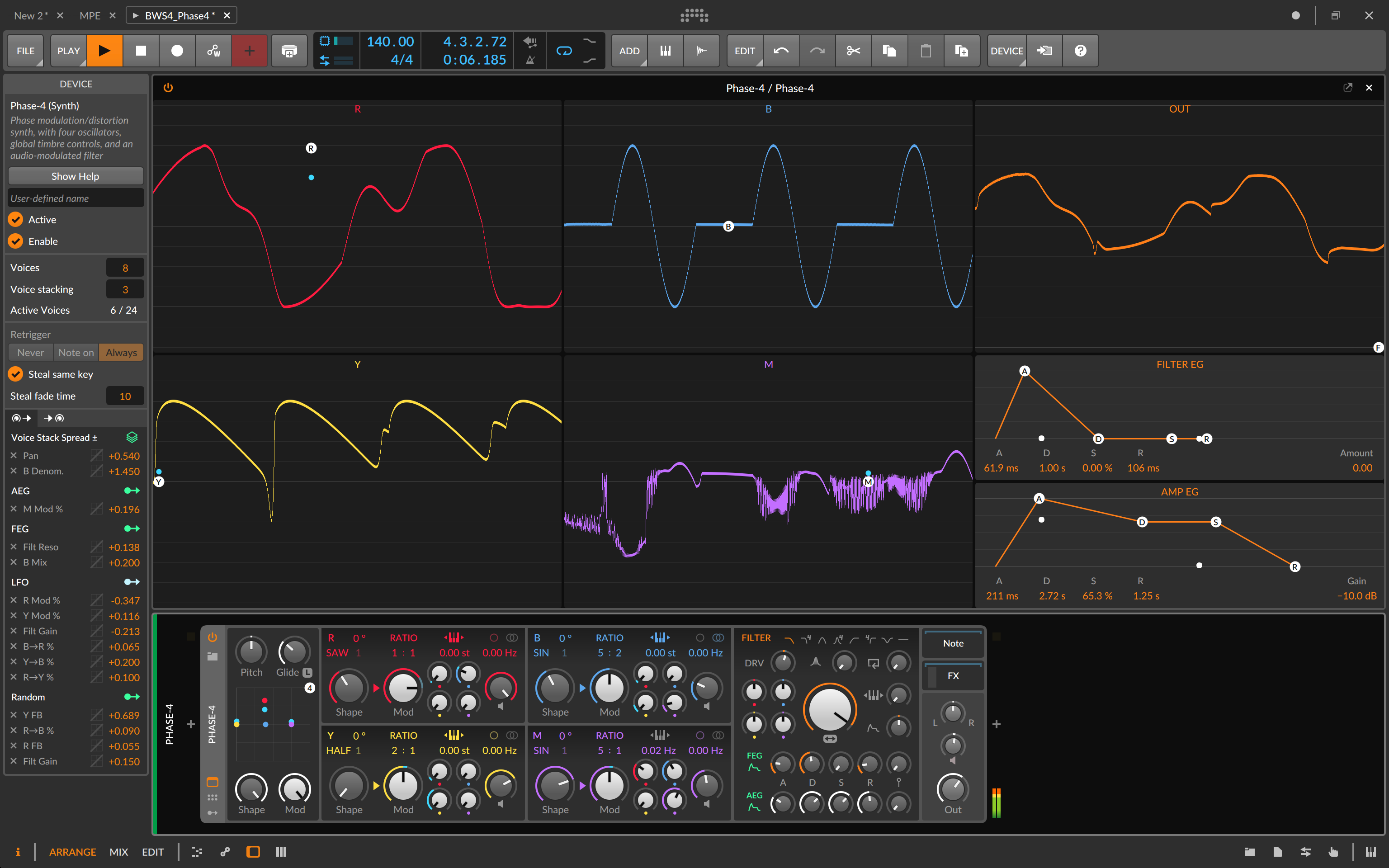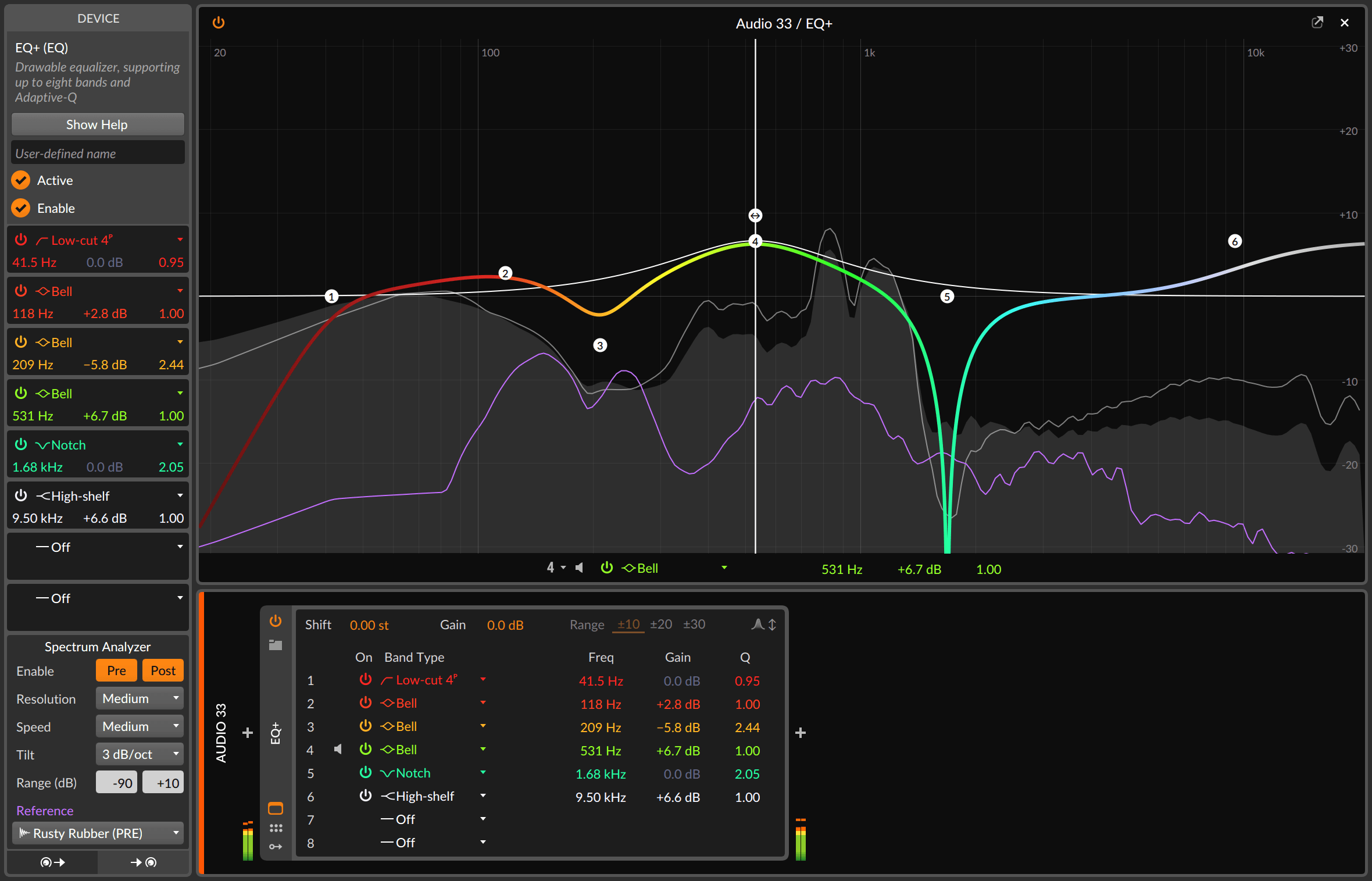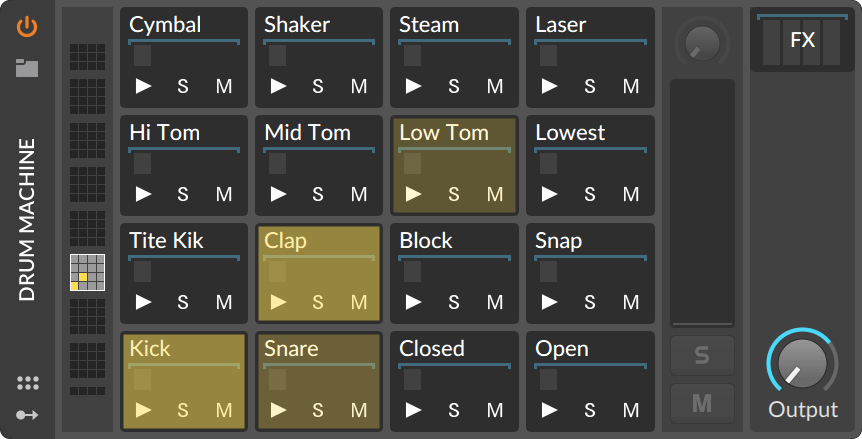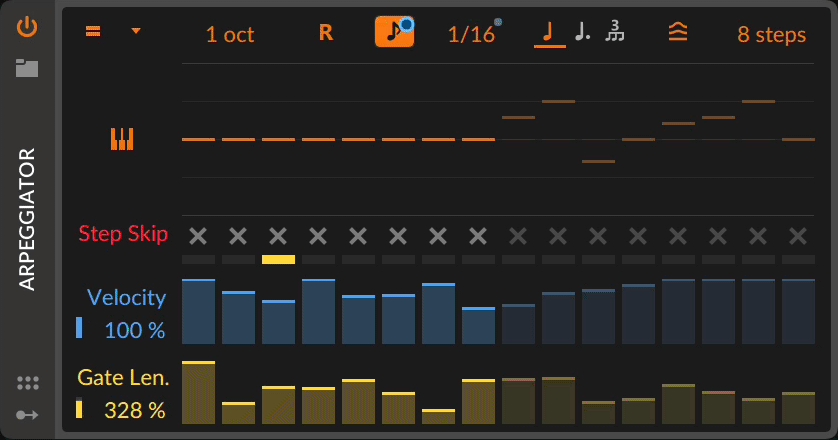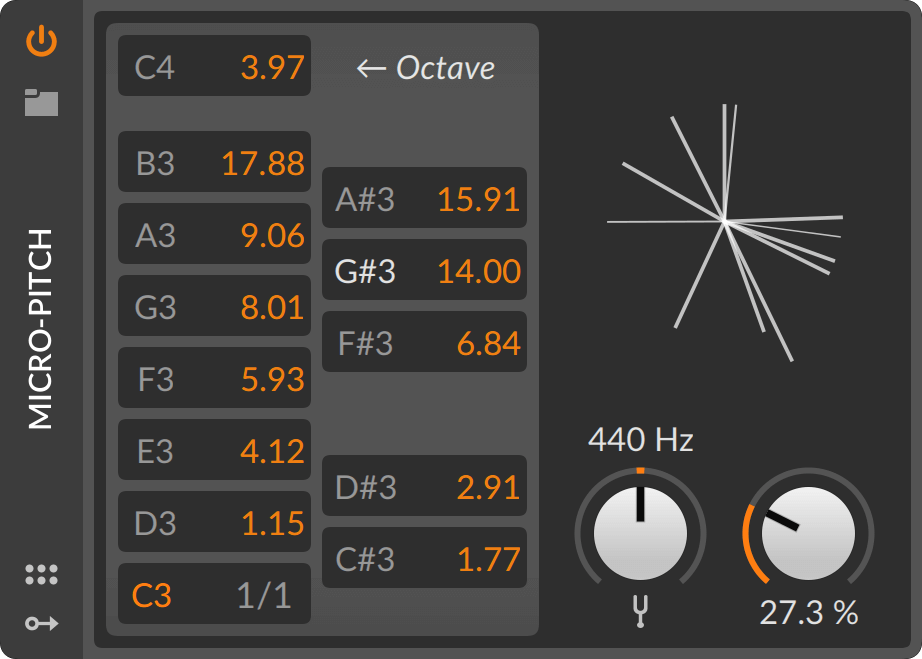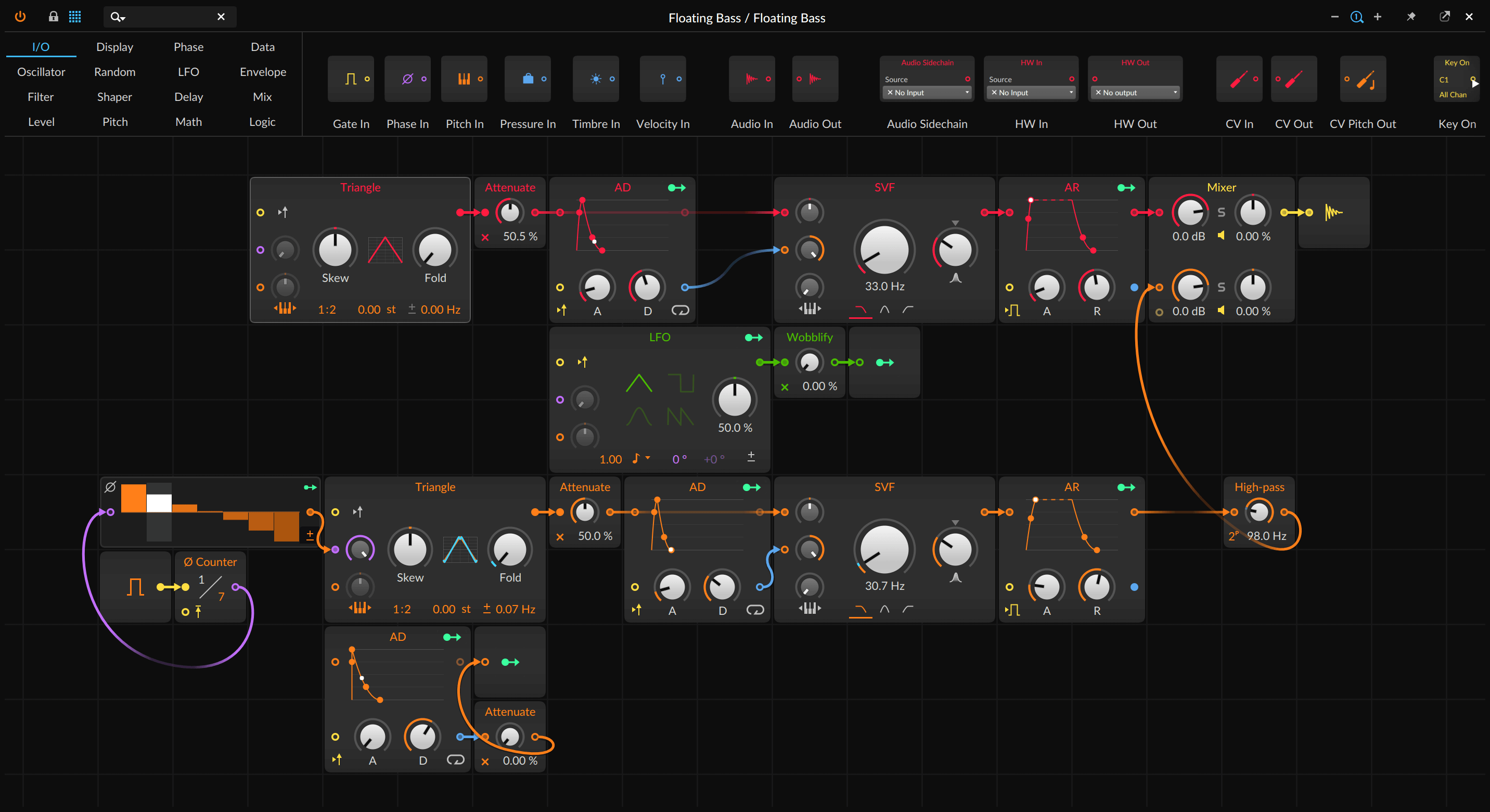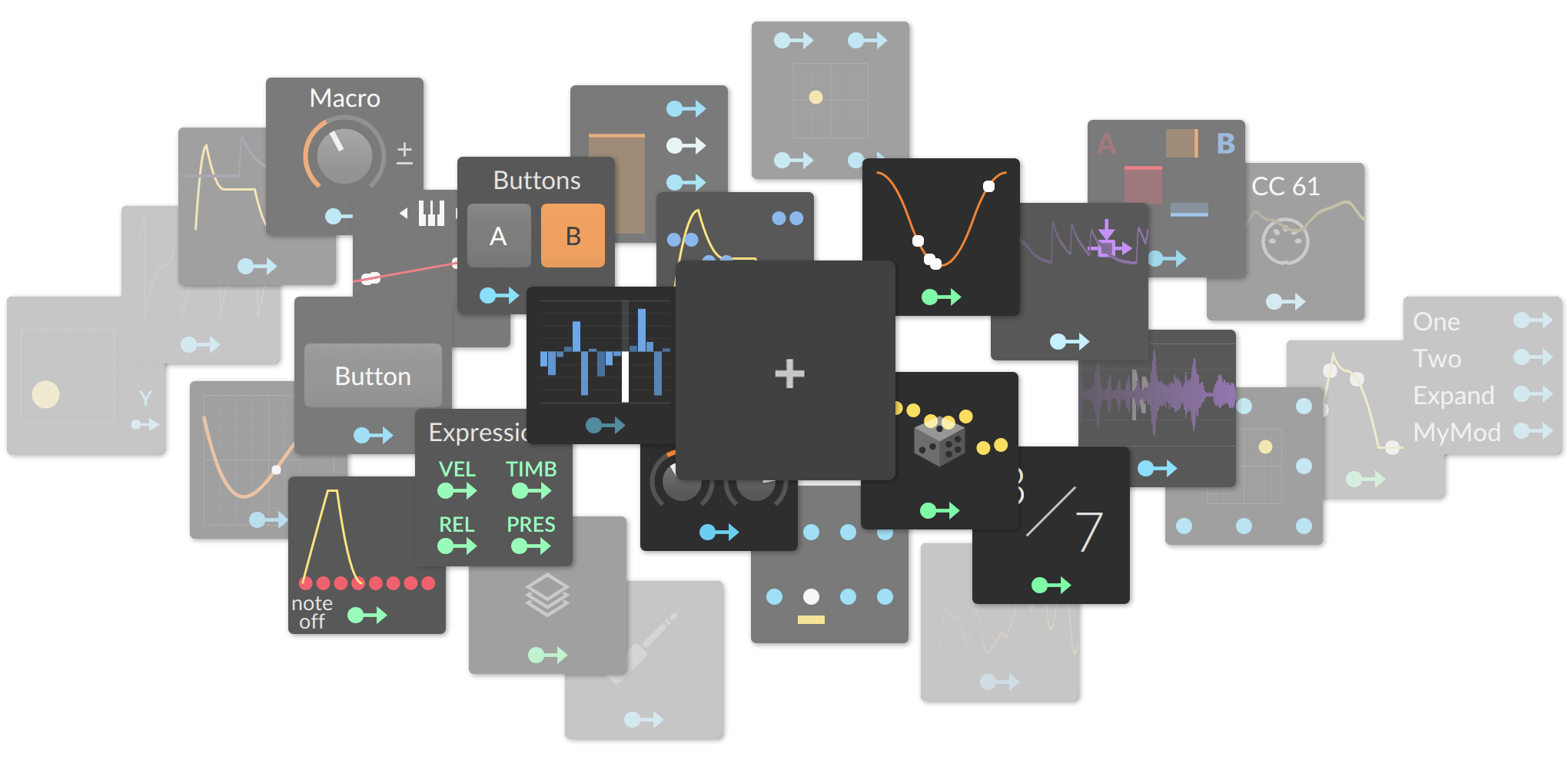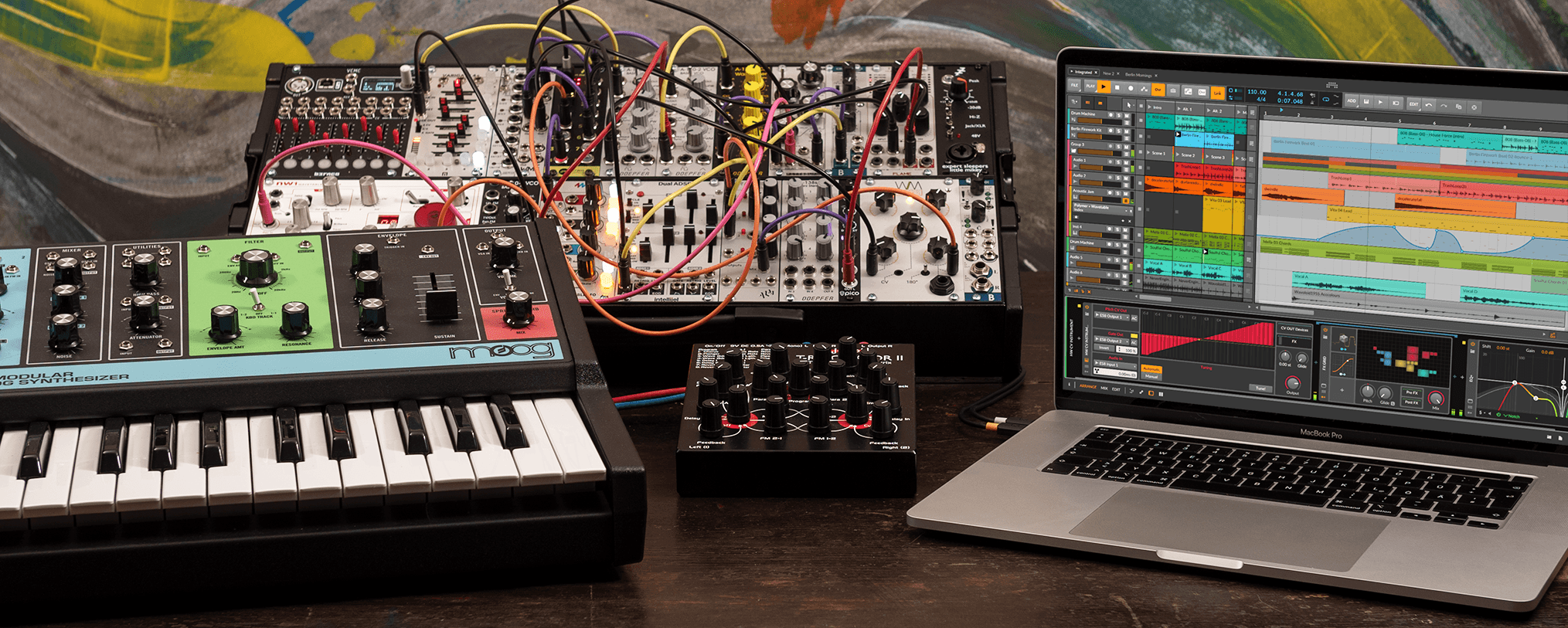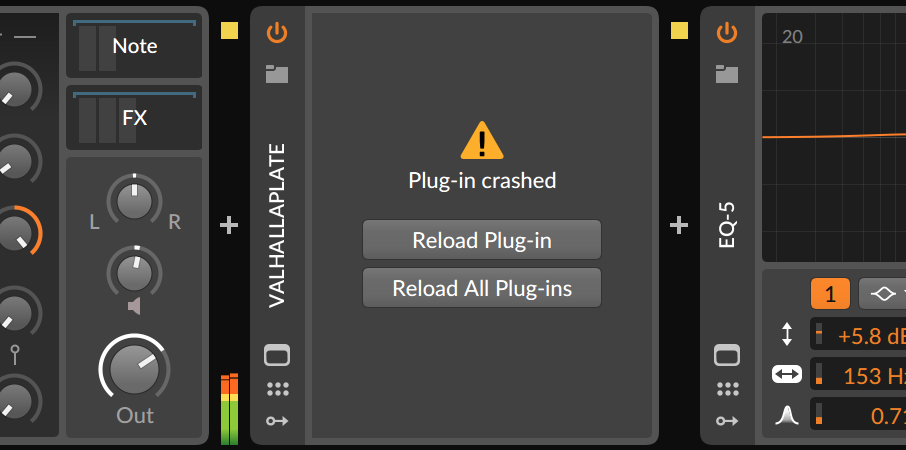- Audio Comping, Anywhere the Clip Goes
- Comping In Action With Tauri
- Operators: Maybe the Best Loops Don’t
- Anti-Loops
- Expression Spread, with a Splash of Total Control
- Native on Apple Silicon, and your VSTs can come
- And Then Some
- Availability
- Customized Workflow To Match Any Style
- Powerful Editing Tools
- Audio Editing
- Expressive MIDI Support
- Time-Stretching
- Instruments & Effects
- Polymer
- Sampler
- Phase-4
- Drum Machine
- Arpeggiator
- Micro-pitch
- Enter The Grid
- Modulation Heaven
- Hardware Integration
- Modern Foundations
- Crash Protection
Audio Comping, Anywhere the Clip Goes
Since the invention of studio recording, our task has been to create the perfect performance. Comping allows you to combine the best parts of many takes, and Bitwig Studio provides this and more.
Each take is given its own color so from the first swipe of a take lane, the sources are clear. To swap in a different take, just tap it. Then press the up or down arrow to cycle thru the other takes. From the composite lane, move a boundary by clicking, adjust gain by dragging, or fix timing by sliding.
Since we have a Launcher and an Arranger, comping lives inside the audio clip. So if you are composing in the Launcher, just click to enable comp recording right there. Or just drag clips in either direction with your takes safely inside. Even open the layered editor when multiple comps belong together. Comping works wherever you are, now and later.
And since all good techniques deserve a new trick, right-click any audio clip to Fold To Takes. If you ask for an eight-bar comp, the entire clip will be spooled into take lanes, and the comping can begin. Or just drag audio in to add a new take lane. The stranger the sources, the newer the result.
Comping In Action With Tauri
Learn how experimental pop duo Tauri used the comping workflow in Bitwig Studio 4 when producing their song «In The Dark.» The song is out on all major music platforms, and it’s also available in Bitwig Studio 4 as a full Bitwig demo project for you to explore and remix.
Meet Tauri and get a behind-the-scenes view of their comping workflow in this in-depth artist story.
Operators: Maybe the Best Loops Don’t
Modulation has always been a centerpiece of Bitwig Studio. Modulators have been there all along, putting device parameters into motion. And now with Operators, sequenced note and audio events can become electric too. This leads to clips that go to different possibilities and timelines, either by programming, by performance control, or by destiny.
Operators include four modes, which can be used individually or in any combination:
Chance makes each event more or less likely.
Repeats allow each event to retrigger at a set rate, or just divide the note length into any number of pieces. Yes, you can ramp the timing of these (and the velocities for note repeats). And a Slice at Repeats option is available to print out the individual events.
Occurrence sets conditions for each event, like: Is this the first loop of the clip or not? Is the performance-control Fill button turned on? Or did the previous event play, or was it silent?
Recurrence thinks of each event as its own looping timeline. So pick a cycle length (say, every four loops of the clip), and then check-off whether the event plays on each of those four passes.
Add it all up and what do you get? How about a steady stream of 16th notes each with a 50% chance, producing a consistently different rhythm each time. Or a cymbal on beat 1 that plays every fourth clip repeat and never on the first trigger. Maybe connecting two notes so that either the first one plays or the second, but never both. Or maybe you use repeats to create audio polyrhythms, or to simply «ratchet» a single note into dozens of retriggered events with a timing ramp.
And when you need to take your chances on something certain, you can Expand a clip, printing out two, twenty, or however many cycles of the original as a new clip. This lets you see all the nested patterns and relationships that Operators can bring to a «simple» loop, or even start a precise edit without the randomness. Putting down the dice is an equally valid choice.
Anti-Loops
Bitwig Studio 4 sees the arrival of comping for audio clips and Operators for all sequenced events. The brand-new sound package Anti-Loops uses these features to push the idea of what a loop is to the breaking point, with 100+ clips crafted by expert sound designers like Cristian Vogel, Pat Cupo, Polarity and others.
Expression Spread, with a Splash of Total Control
Bitwig’s engine uniquely allows expression automation for notes and audio.
And since randomness was in the air, we brought a visualized Spread range to any expression point. Yes, you can give note velocities randomization, but you could also give each piece of a chord its own panning. Or create a note that starts in tune and then drifts to a random pitch. Or give each slice of an audio clip a slightly randomized gain.
We trust you’ll find the right use(s) for it.
With the editor open, all destined random values are visualized when the clip starts. And then again, the new values appear when the next loop cycle begins. When the interface and sound is this tightly connected, you’ve harnessed the chaos and can just make music.
You can even cast the dice yourself by clicking the Seed field of any clip. If you like what you hear, that same «random» pattern is now locked in for all Spread parameters — and any events with a Chance Operator. No risk, no problem.
Native on Apple Silicon, and your VSTs can come
When new computers arrive, software must follow. Apple is making their own M1 processors, so now Bitwig Studio runs natively on Apple Silicon.
Some more good news is that your Intel and ARM VSTs can live alongside each other. Bitwig has always handled plug-ins differently, hosting them separately from the DAW. Because if a plug-in has to crash, it is better that Bitwig keeps playing. And now this means mixing VST architectures as well, and just as safely.
Each platform is different, and we support three of them (greetings, Linux penguins!). So whether it is Apple Silicon, a full multitouch interface for Windows and Linux, or native CV and MPE support for everyone, Bitwig is the DAW that connects all these technologies as soon as you have them.
And Then Some
Bitwig Studio is now localized in Chinese, Japanese, and German. The interface remains the same, but functions, labels, and in-app documentation — including the Interactive Help for our 300+ devices and modules — can be displayed in any of these languages.
Since Operators have a performance angle, the new Globals modulator came along as well, providing the current value of the Fill button, the position of the global crossfader, and more. Because while per-note control is fantastic, so is assigning a couple global controls to all of your tracks.
No matter which editing tools and devices you use, it all becomes audio in the end. With version 4, our export options have improved, allowing you to select from lossless formats (WAV & FLAC), familiar lossy options (OGG & MP3), and a new contender (OPUS). So select part of your arrangement and bounce it to one or more formats. Or pick your top-level group tracks to export stems in a flash. No reason to complicate it.
Chances are you have more than one music program on your computer. (We do.) So on the import side, you can now import data from your FL Studio (FLP) and Ableton Live (ALS) files into Bitwig. Your clips and arrangements should make it over pretty cleanly, as well as VST plug-ins. And if you are coming from Auxy, you can now export your work directly as a Bitwig Studio project. Because maybe the best demo song is one you already made.
And some other improvements have come along too. Content sliding (and gain handles for audio) is available directly at the clip and event level with visual handles that appear while you work. To make audio easier to read, waveforms are now shown in a Perceptual scale (or switch back to Linear in the Dashboard). And most of our Grid and Polymer filters have a smoother response now for extreme resonance and modulation cases.
Availability
Bitwig Studio 4 is out now and it is a free upgrade to everyone with an active Upgrade Plan for Bitwig Studio. All new features except comping are also part of Bitwig Studio 16-Track and 8-Track. View the full Bitwig feature comparison chart here.
Bitwig Studio 4
There’s one installer for all versions of Bitwig Studio. This includes the full version of Bitwig Studio, as well as 8-Track, and 16-Track.
The changelog and release notes are available here.
Источник
Customized Workflow To Match Any Style
Bitwig Studio is the single solution for realizing any musical idea across every stage of production.
Powerful Editing Tools
We want to help you make your musical ideas happen, in as few steps as possible. Focus on the music, not the tool.
Audio Editing
The Detail Editor optimizes audio editing by letting you make edits within a clip. This allows you to stretch, split, pitch, pan, copy, reverse, add, move, and rearrange audio as you choose.
Expressive MIDI Support
In addition to standard note-editing features and per-note expressions such as velocity, gain, pan, timbre, and pressure, Bitwig Studio features unique tools like quick actions, micro pitch, and sophisticated layered editing, and is a forefront runner in supporting MPE.
Time-Stretching
Keep your audio material in time regardless of project tempo using Bitwig Studio’s state-of-the-art time stretching. Let Bitwig Studio analyze and automatically stretch your audio, or take full control and use our advanced stretching and editing tools.
Bitwig Studio comes with 8 different time stretch algorithms to cover all your musical needs, including the renowned Zplane Elastique in four flavors.
Instruments & Effects
Here’s a taste of the vast and ever-growing device library that comes with Bitwig Studio. With over 90 different instruments, audio and note FX, container devices, and signal routers you can translate any idea into music.
Polymer
Polymer starts simple: pick an oscillator, a filter, and an envelope generator. Swapping out Grid modules within a dedicated synthesizer is both fast and quick, helping you craft production-worthy sounds from minimal controls immediately.
Sampler
The Bitwig Studio Sampler is a powerful tool for playing and manipulating audio. It boasts several playback modes, advanced looping features with crossfades, endless modulation possibilities, a massive multisample editor, and more.
Phase-4
Meet Phase-4, a four-oscillator synthesizer powered by phase modulation and phase distortion. This unique synth can do classic, modern, and beyond.
EQ+ is a feature-packed graphical equalizer with up to 8 bands, mouse gestures, and excellent visualization and algorithms.
Drum Machine
The Drum Machine is a container device that you can fill with sonic goodness. It’s never been easier to create unique and great-sounding kits.
Arpeggiator
Individual controls for step velocity, note length, and pitch. 17 note patterns, and three modes for handling octaves. Full MPE support. Even modulate the timing for shifting patterns. Holding chords has never been so musical and dynamic.
Micro-pitch
Micro-pitch is a Note FX device that allows you to re-tune your note streams in new ways. Transform scales, fine-tune individual notes, shrink or expand octaves, or even slice the octave into a different number of pieces. Play something unimaginable, today.
Inject a bit of virtual analog grit into your sounds with the Amp device, a remarkable piece of amplifier-simulation technology.
Enter The Grid
The Grid is a sound designer’s dream. It can be a synth, an audio effect, or most things you can imagine.
The Grid is a modular sound design environment, open for you to build your own creations from scratch.
It’s also an expressive instrument with hundreds of high-quality patches for you to explore, ready to play. It’s sophisticated yet easy and fast at the same time.
Explore it, build it, play it.
Modulation Heaven
The modulation system in Bitwig Studio allows you to use Macro controls, Note Expressions, LFOs, and Envelopes to modulate any device, VST plug-in, or hardware parameter. With 30+ modulators (and counting) the potential for creative expression is endless.
Hardware Integration
We love hardware. We also love software. That’s why we want to blur the boundaries between the two.
Let Bitwig Studio control your hardware, or let your hardware control Bitwig Studio, or both, via MIDI, CC, CV, Gate, analog and MIDI Clock, and MIDI Timecode. Enjoy a collection of straightforward tools that allow you to take advantage of the best of two worlds, and that scales with your setup.
Modern Foundations
Building a DAW from the ground up allowed us to think differently and solve old problems in new ways.
Bitwig Studio is made for the future.
Crash Protection
Bitwig Studio handles VST plug-in hosting in a unique way, allowing for different hosting modes and plug-in crash protection. With plug-ins, the audio engine, and other processes running in separate threads, a technical issue won’t bring your whole project down.
Источник

